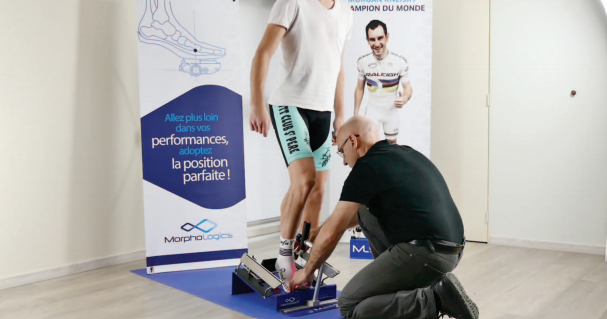Developed and patented by us, the ML Cleat® device optimises the shoe cleat positioning adjustment using a laser system. The position of the foot on the pedal plays a vital role when it comes optimising energy transfer and reducing the risk of pathologies (tendinitis, myalgia, joint pain in the lower limbs, back muscle tension, etc.). By superimposing the axis of the foot onto that of the pedal, we are able to obtain a perfect alignment and optimised energy transfer. By adjusting the cleat position, cyclists are guaranteed optimised performance, comfort and individual health.
The ML Cleat is able to identify the joint of the first metatarsal using a laser beam and then transfer the measurement between the heel and the first metatarsal onto the sole of the shoe. Measurements are taken for each foot individually to take into account their individual morphologies. The measurement transfer, which consists of aligning the centre of the cleat with the laser beam, takes the curve and thickness of the cycling shoe into account, and therefore also its shape and the level of wear.
Used by over 500 partners (including shops and sports doctors), the ML Cleat® works for all types of cycling and all cleat brands, enabling cyclists of all levels to pedal optimally!
In addition to improved mechanical efficiency, a good position of the foot on the pedal significantly reduces the risk of pathologies: tendinitis, myalgia, joint pain in the lower limbs or back muscle tension.
Cyclists pedal at an average rate of 90 rpm, and this cadence can increase to more than 110 rpm during competitions. Based on a rate of 90 rpm, this adds up to 5,400 pedal revolutions per hour and approximately 18,000 pedal revolutions per 100 km. Incorrect positioning of the foot/pedal interface can be detrimental to both the cyclist’s health and performance.
The ML Cleat is able to identify the joint of the first metatarsal using a laser beam and simultaneously transfer the measurement between the heel and the first metatarsal onto the sole of the shoe.
Measurements are taken for each foot individually to take into account their individual morphologies. The measurement transfer, which consists of aligning the centre of the cleat with the laser beam, takes the curve, thickness and level of wear of the shoe into account.

The most important support point for optimising pedalling efficiency is the point of contact between the foot and the pedal. Thanks to the ML Cleat®, the positions of all existing bike cleats can be adjusted quickly and accurately.
The cyclists’ feet can be measured accurately from the heel (calcaneal bone) to the joint at the base of the big toe (sesamoid bone).

It only takes a few seconds to transfer the measurement to the outer sole of the cycling shoe, thanks to the laser beam.

After using the ML Cleat® on the right and the left foot, it is then be very easy to position and attach the cleat to the shoe, since the axis of the cleat must be aligned with the joint at the base of the big toe. The foot will be comfortably positioned in the shoe, the support of the cleat will be perfect and the pedalling efficiency will be fully optimised.